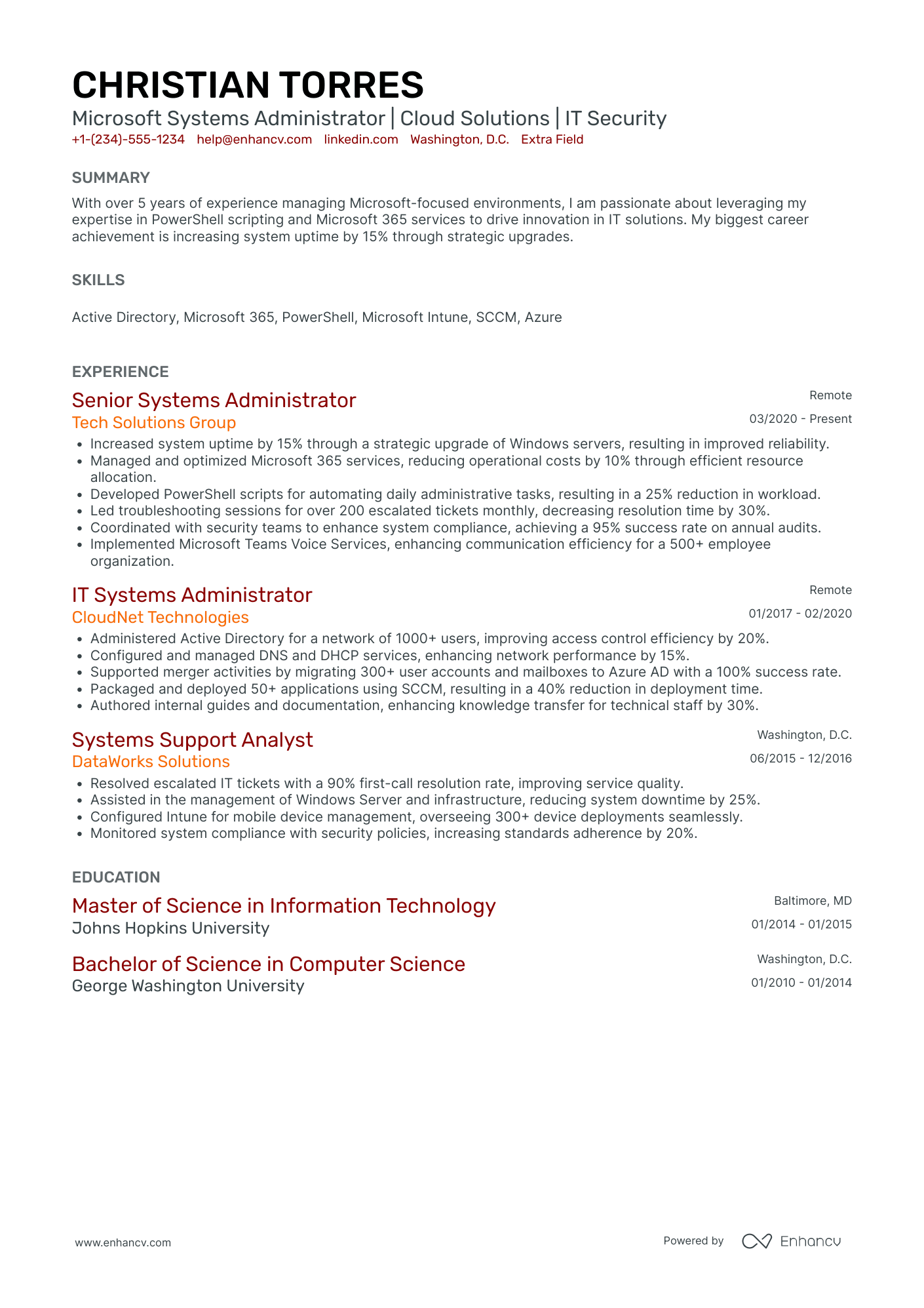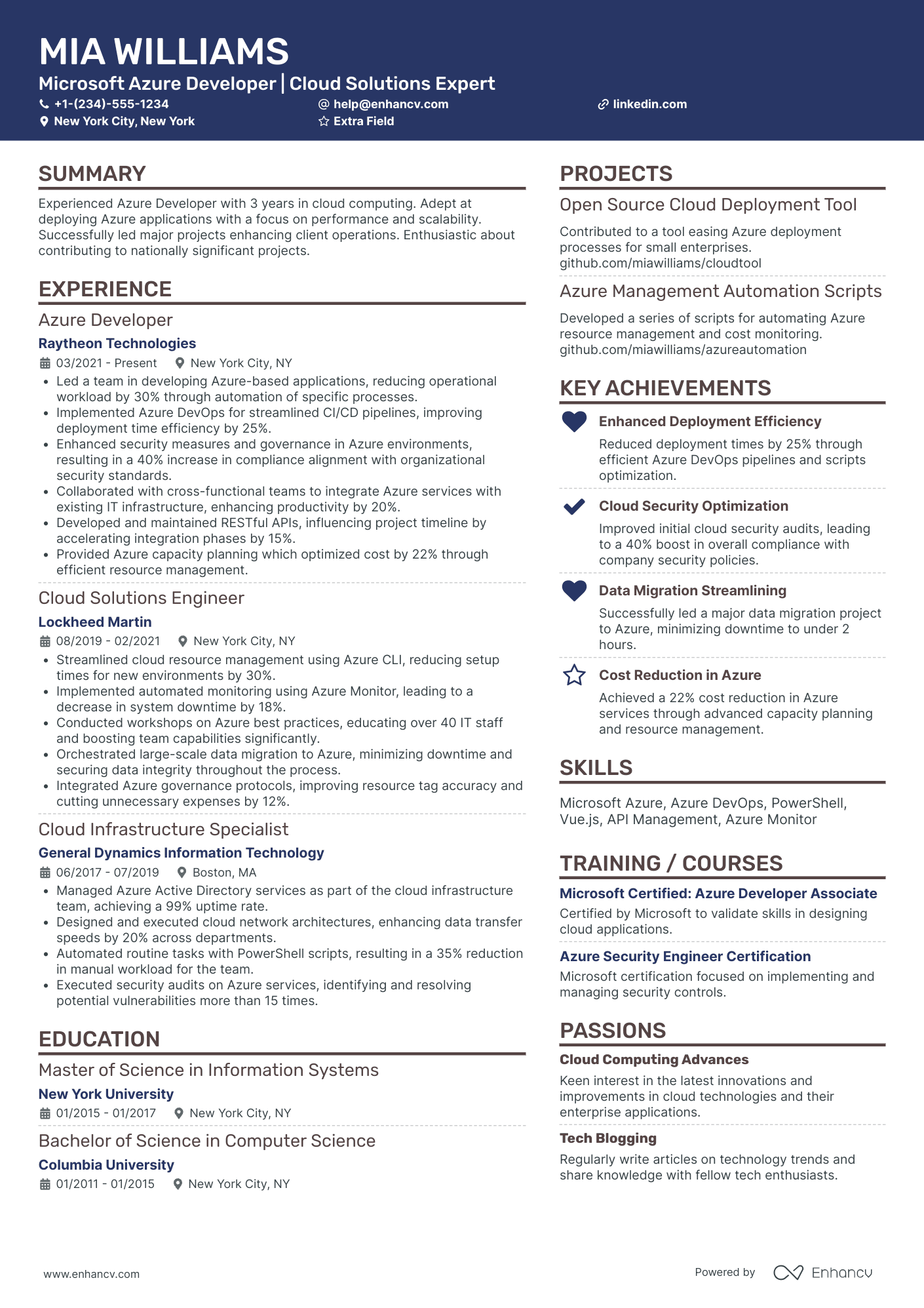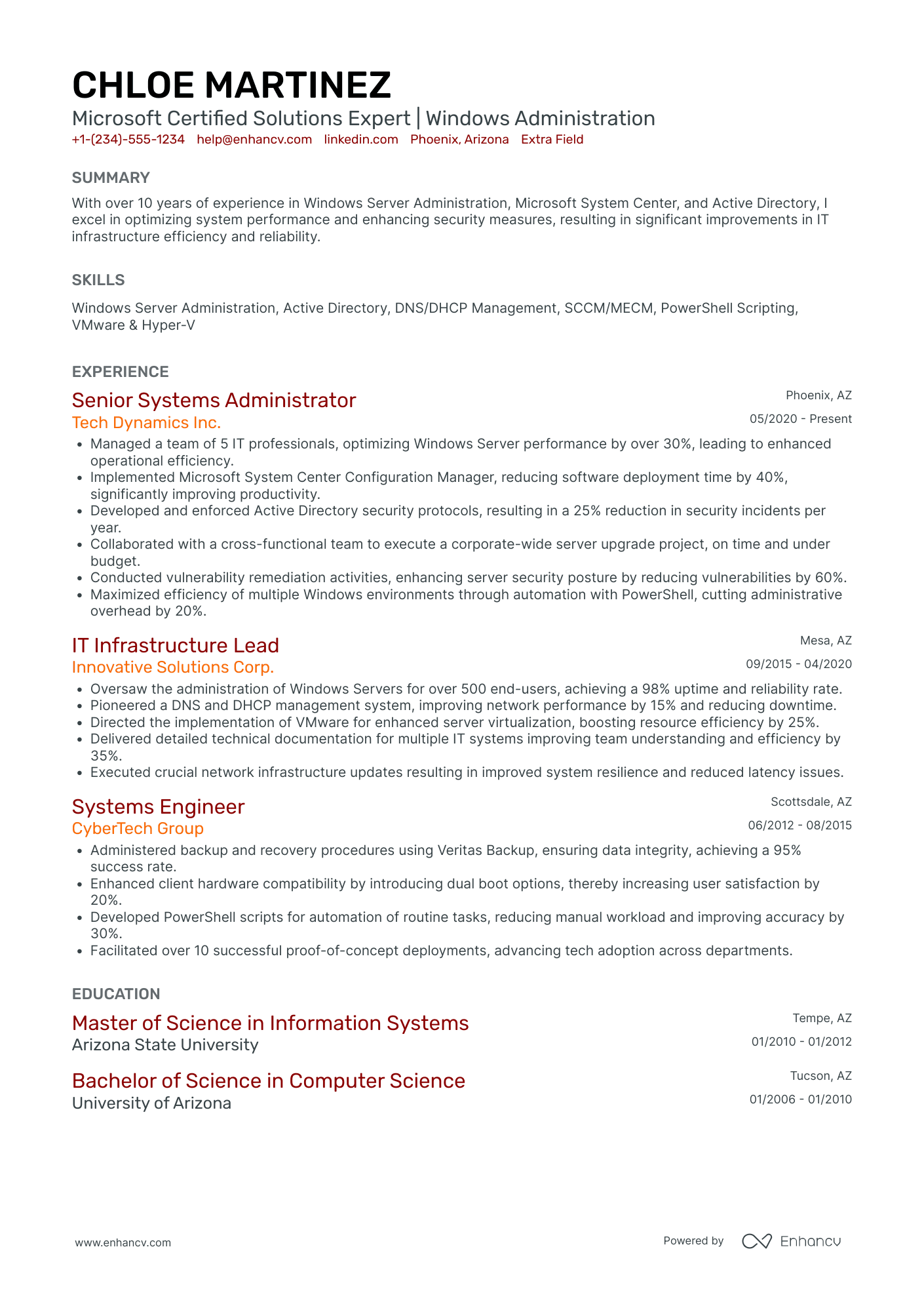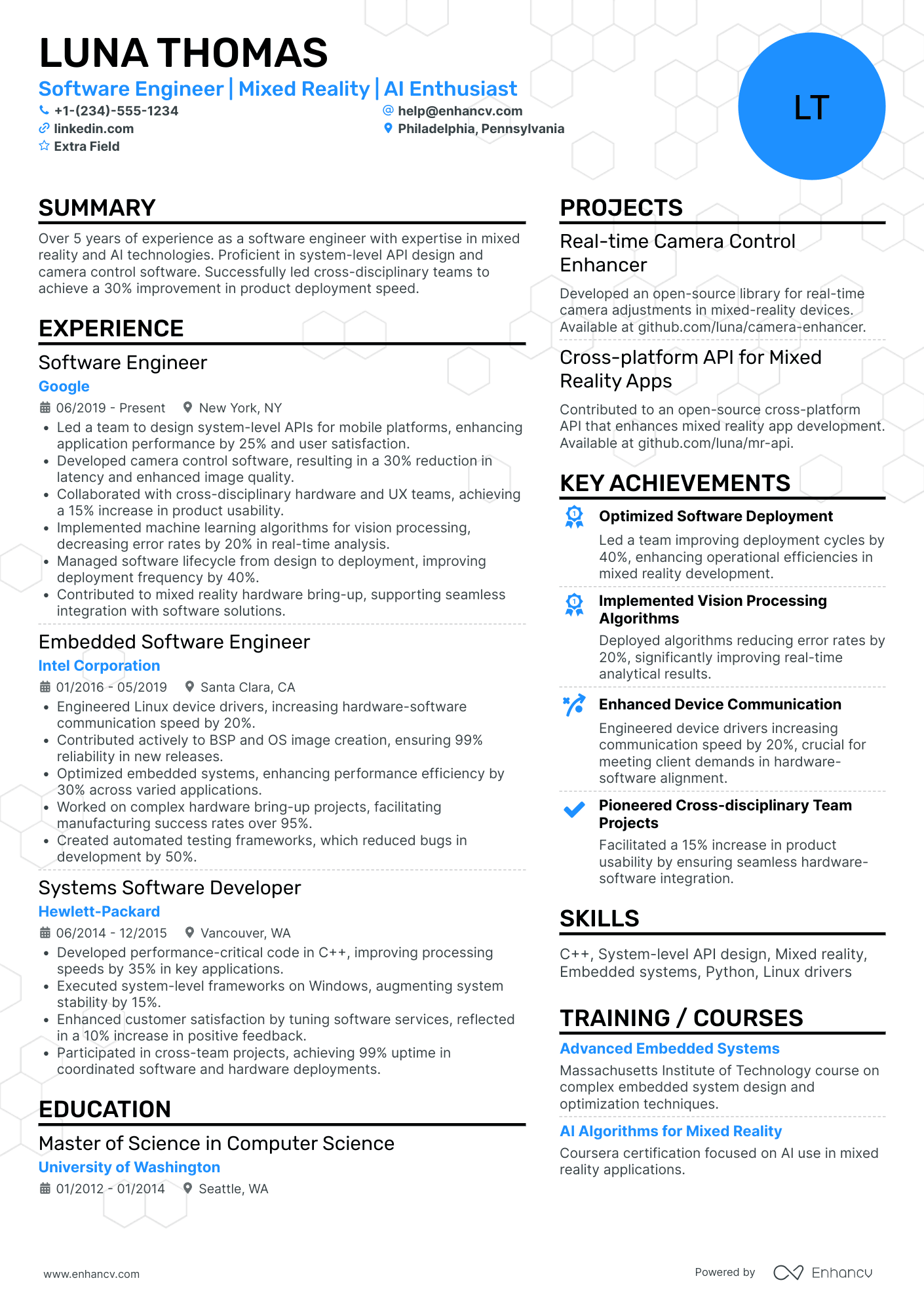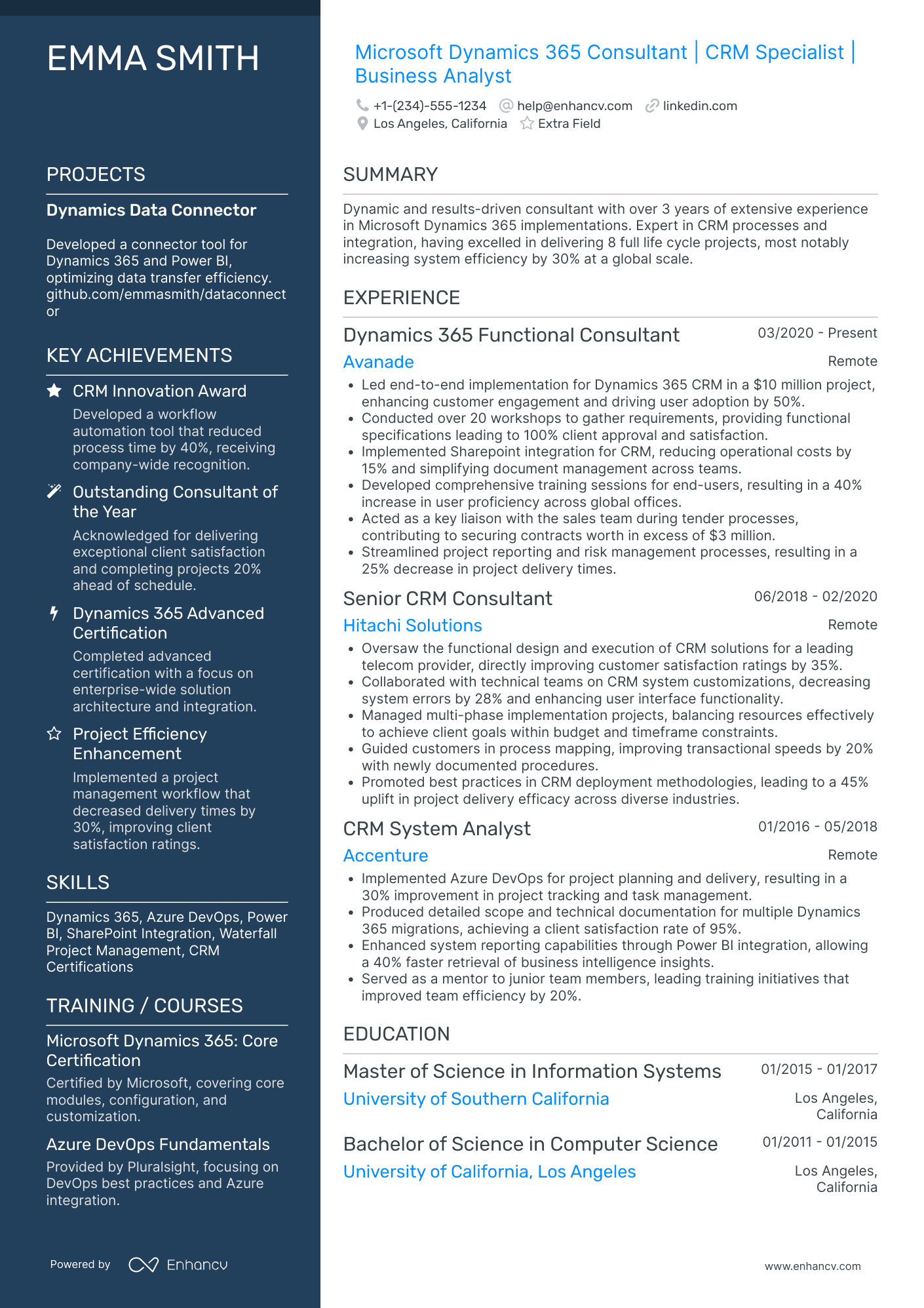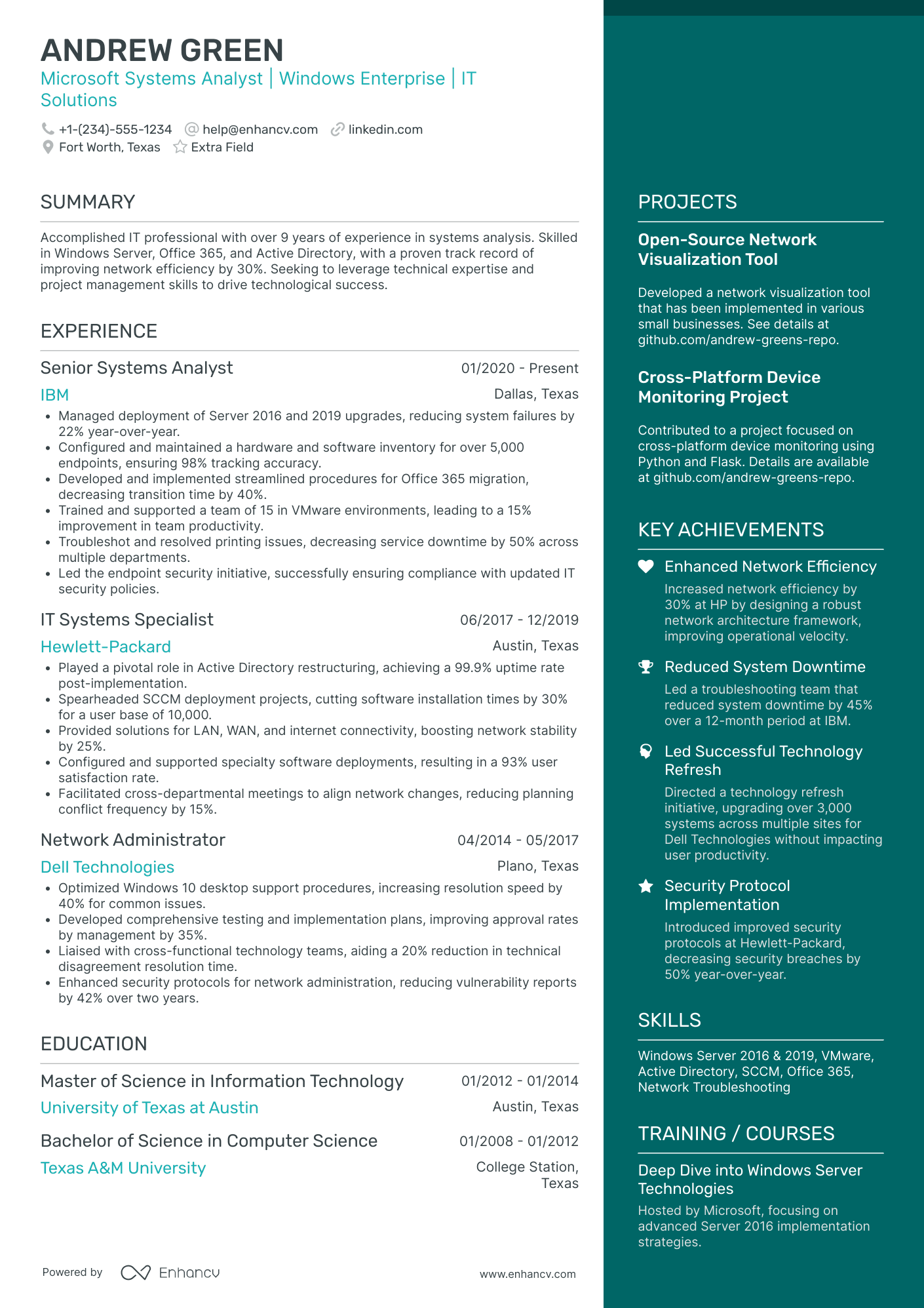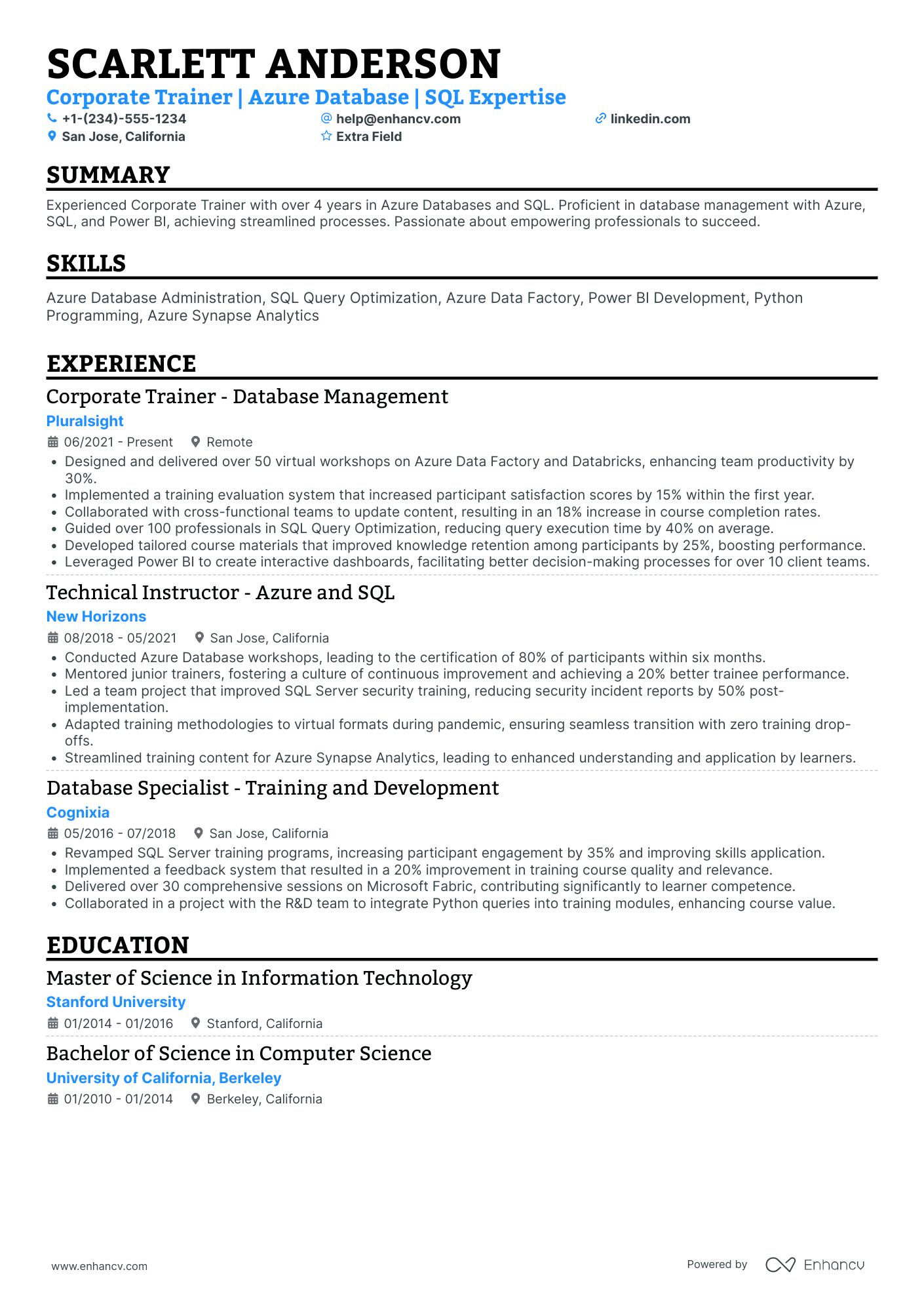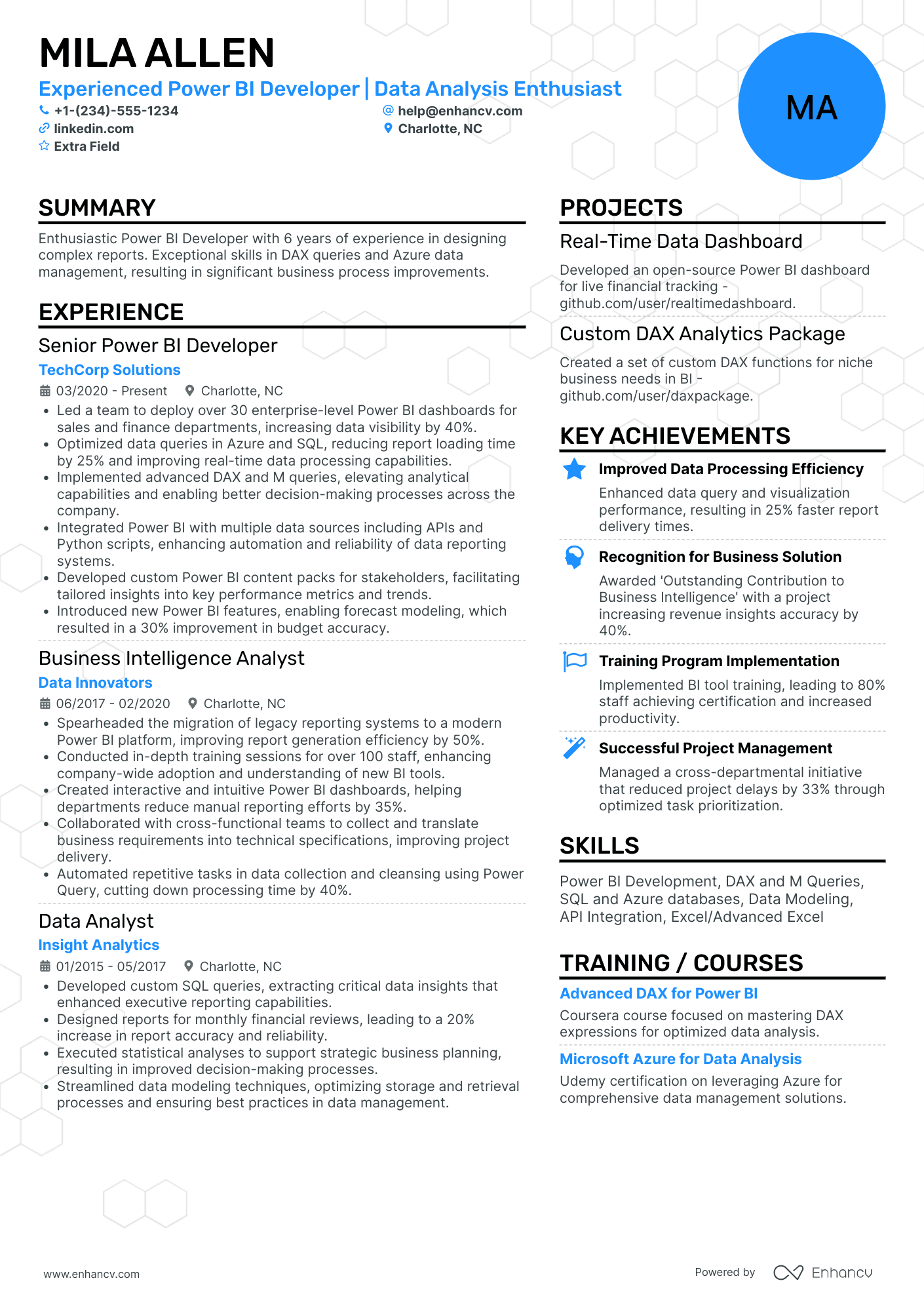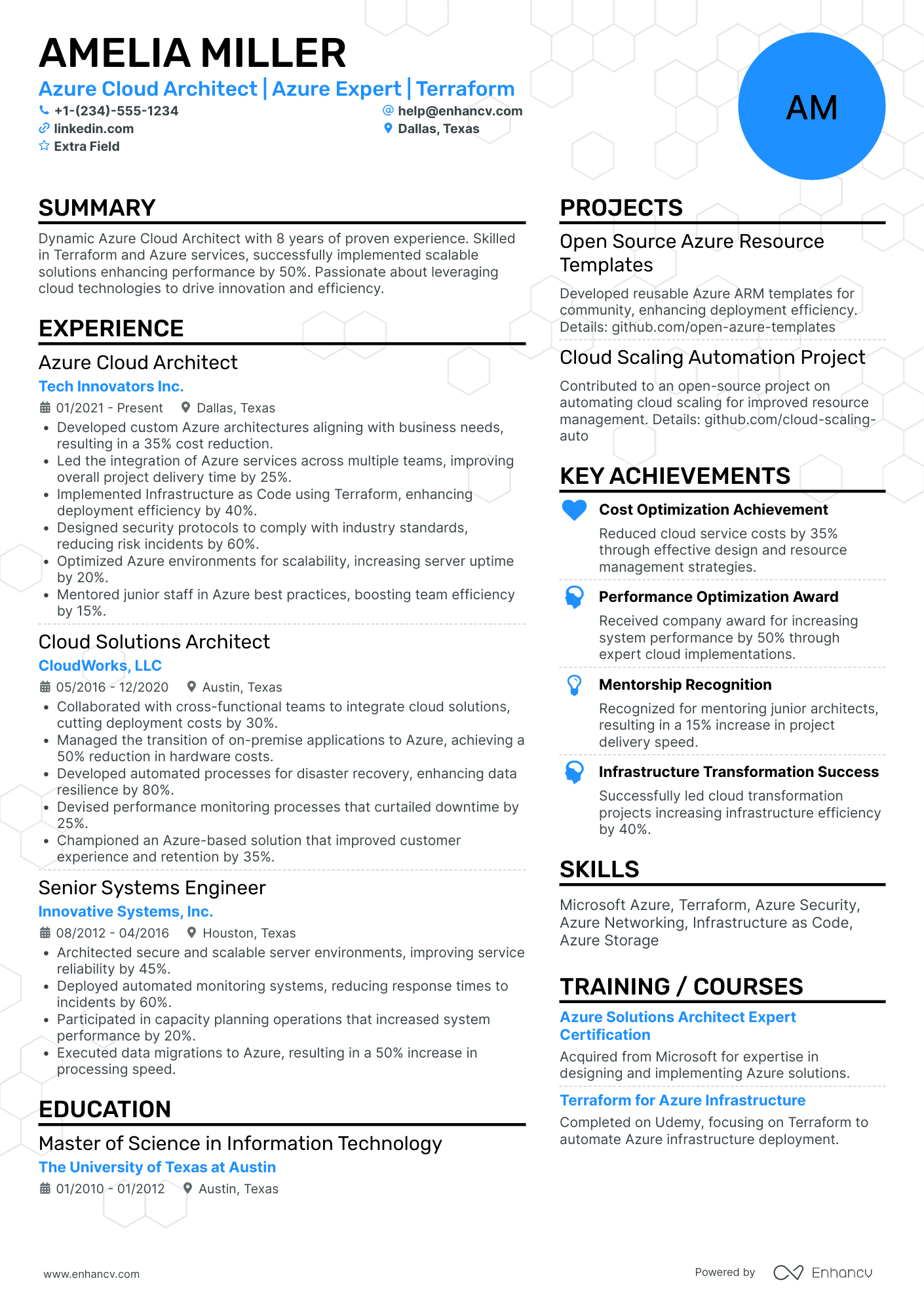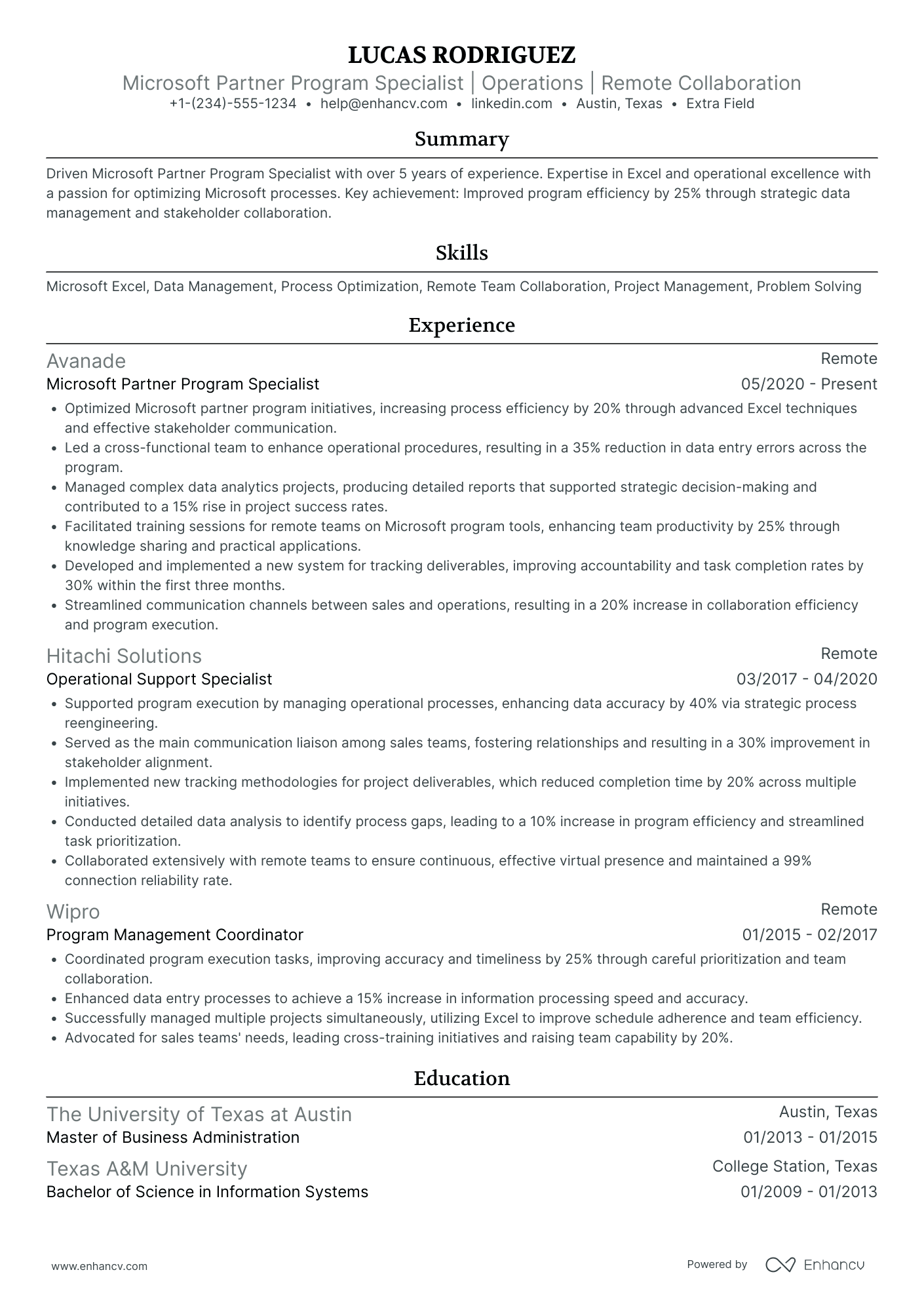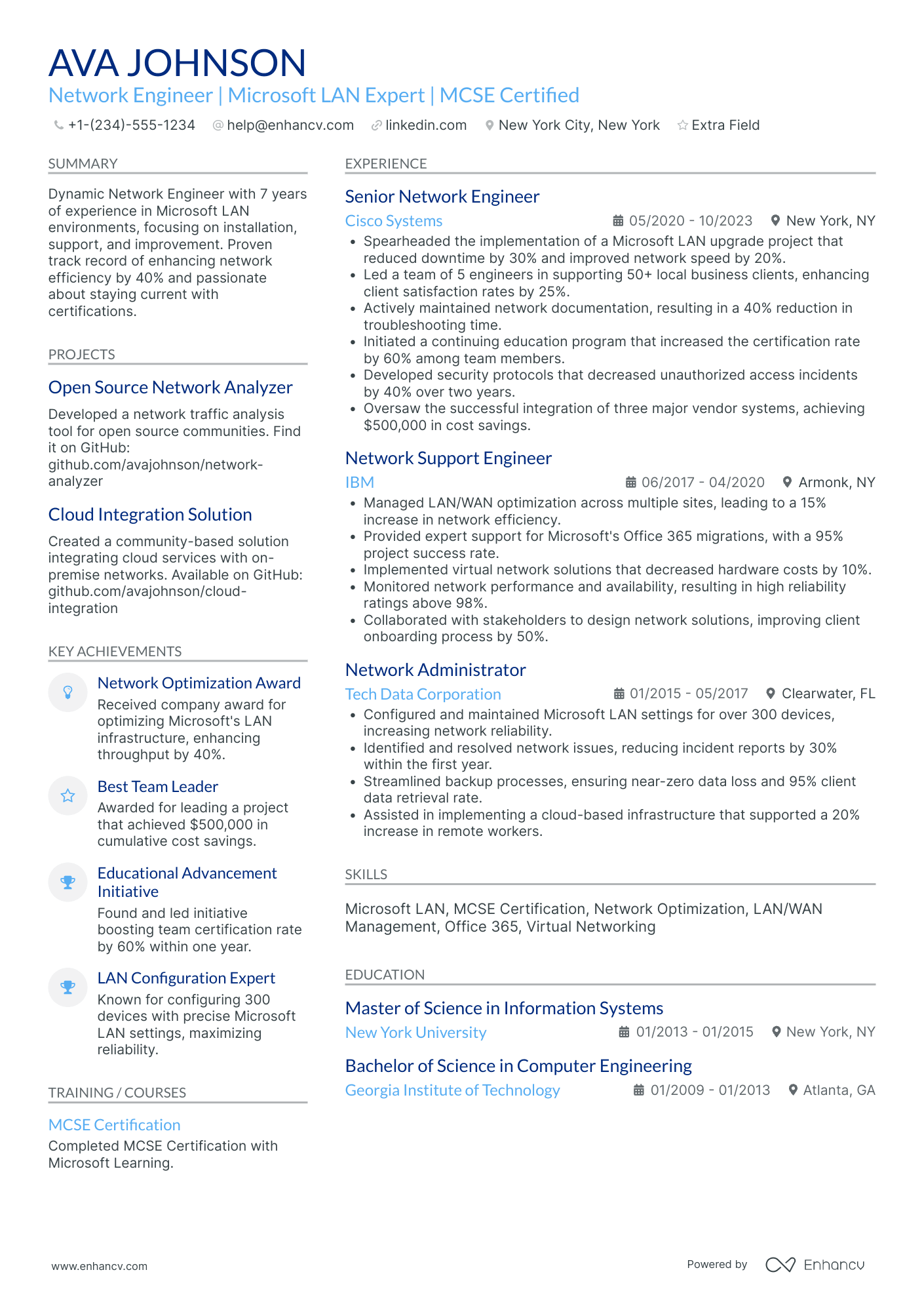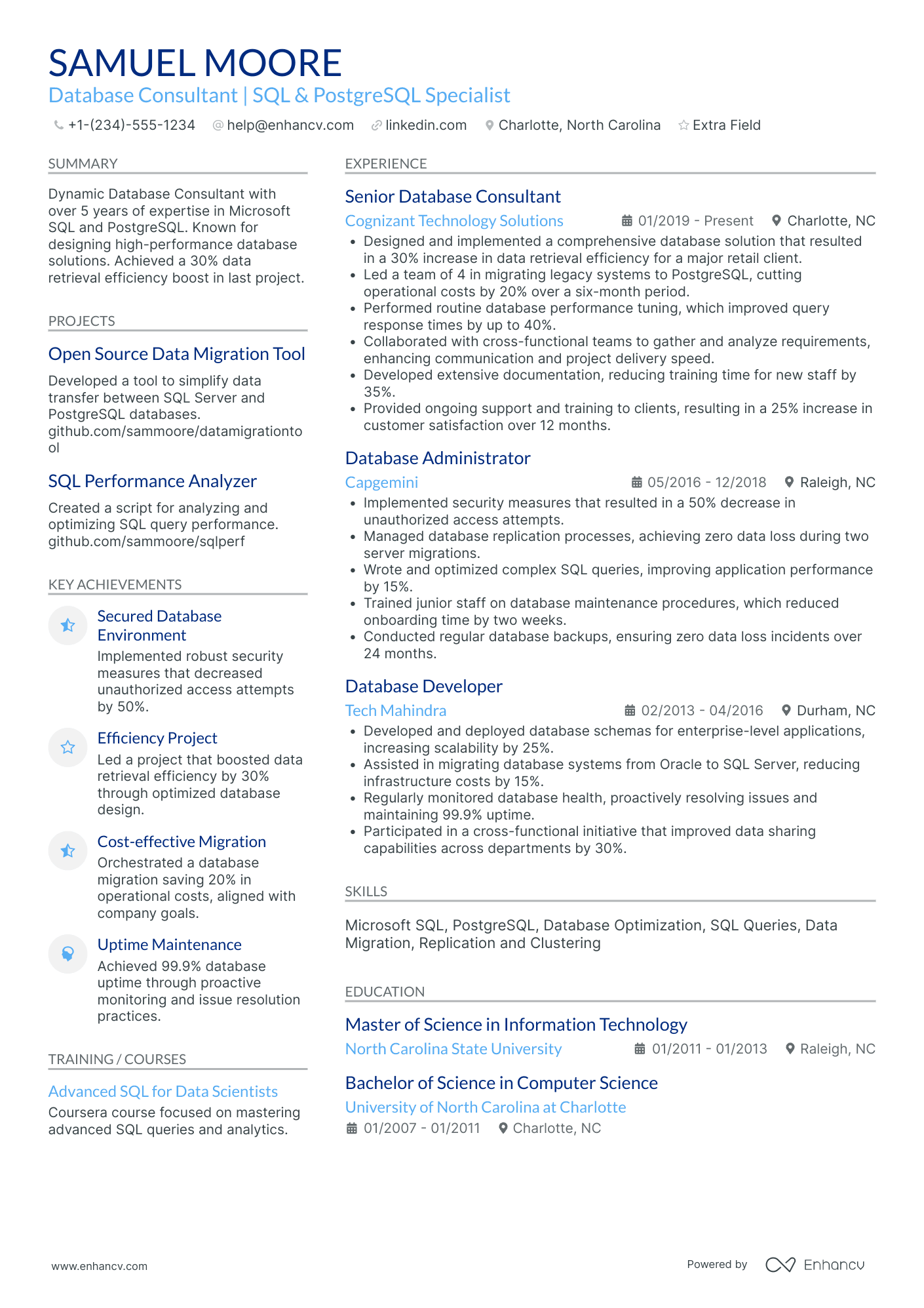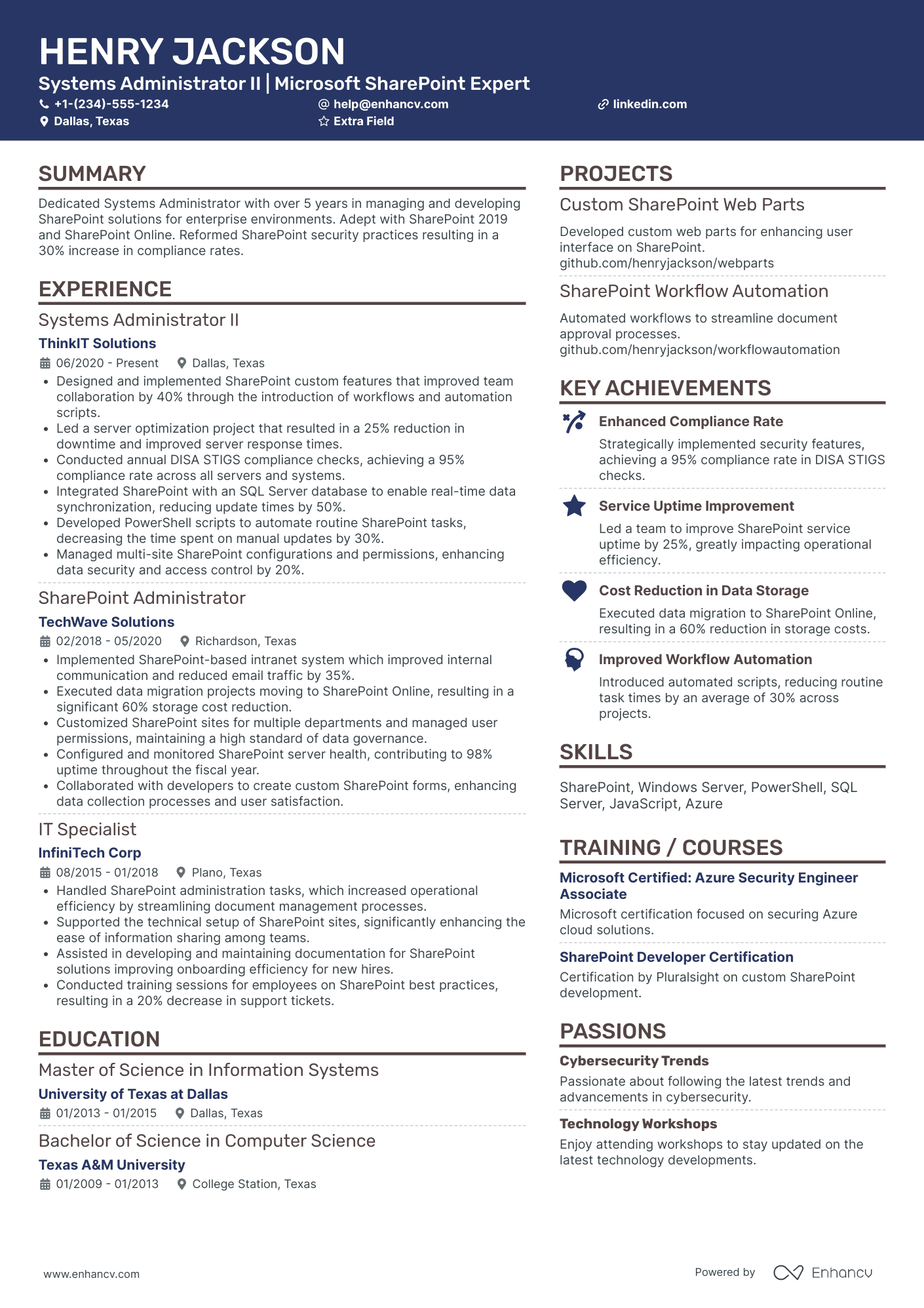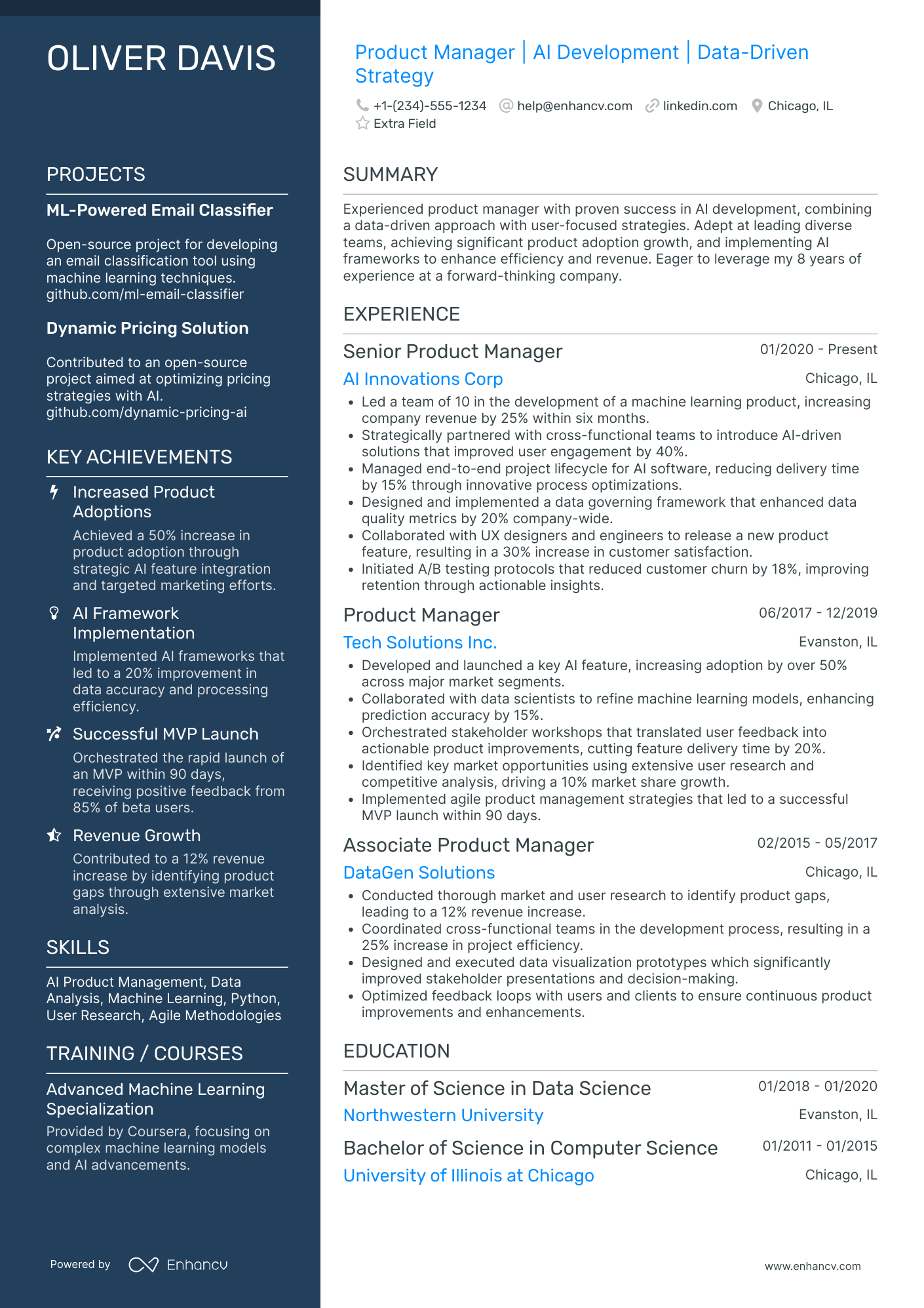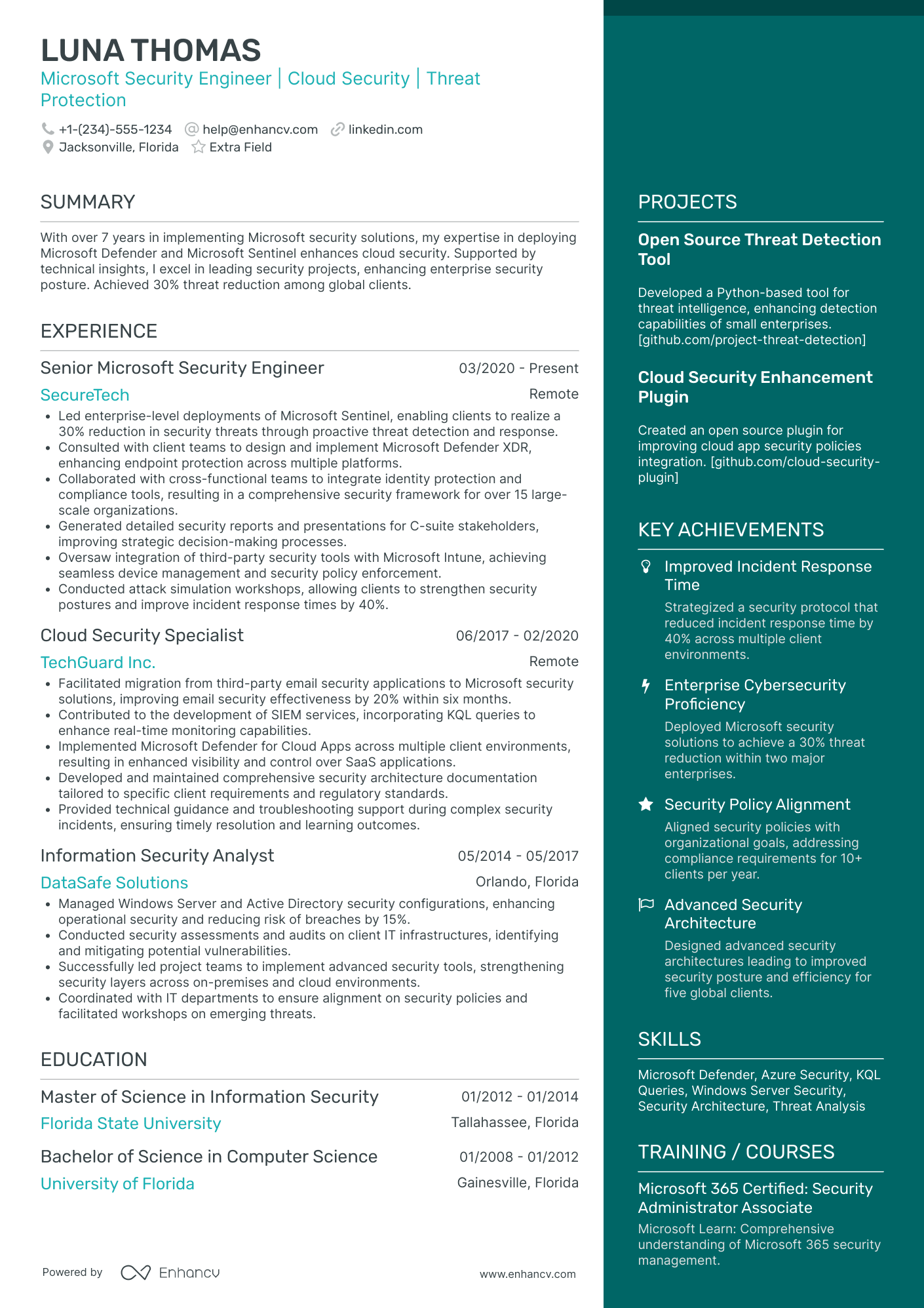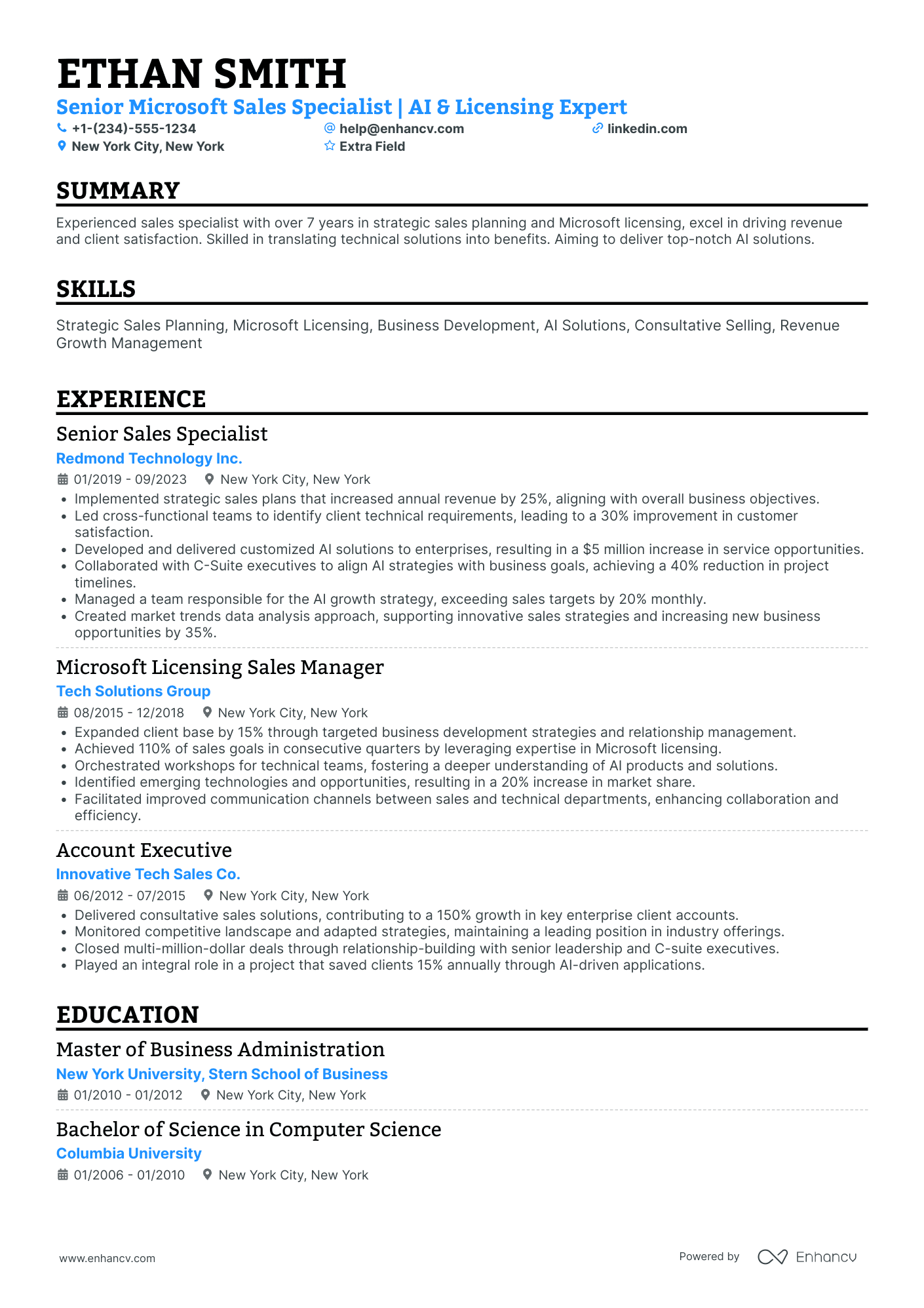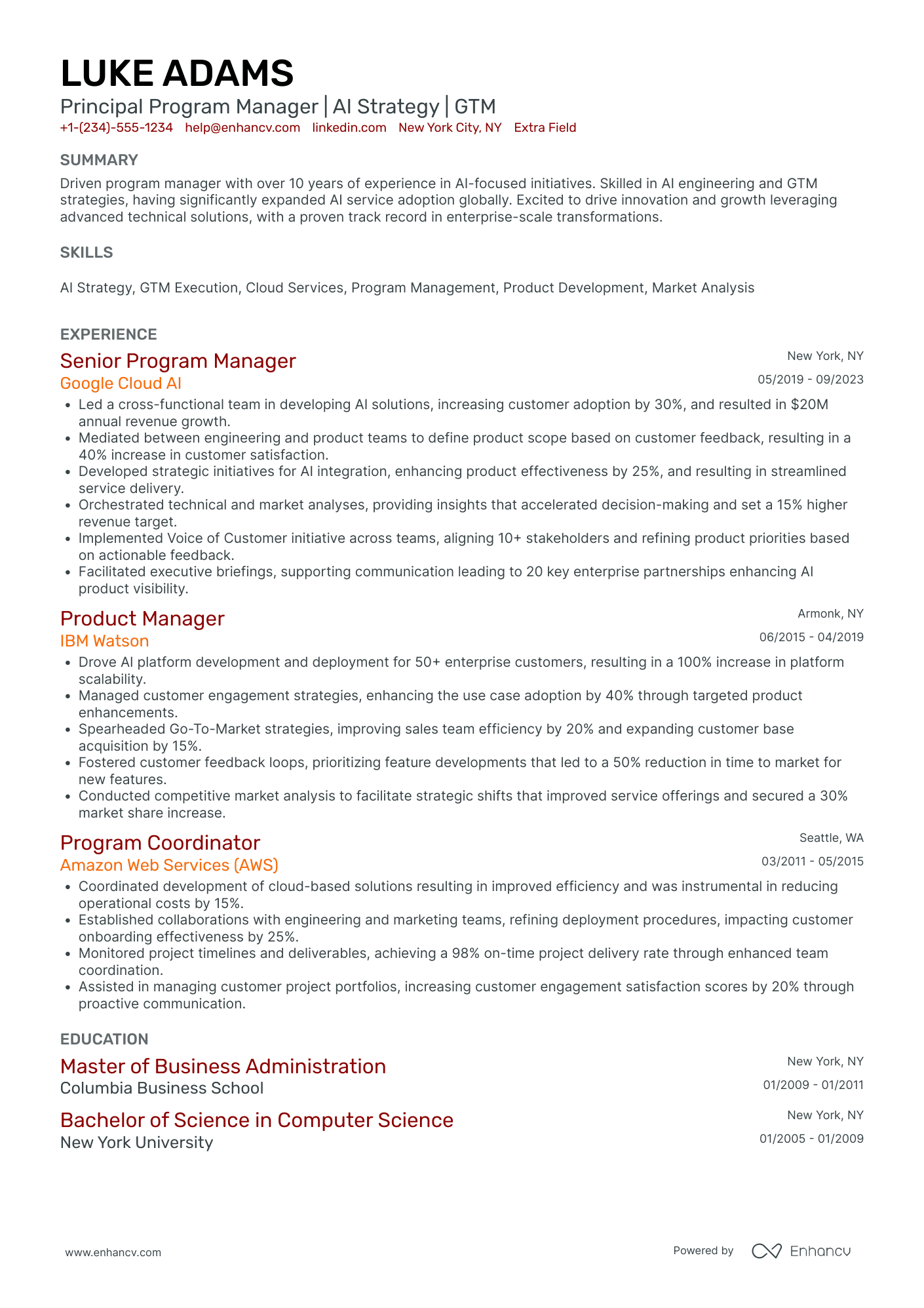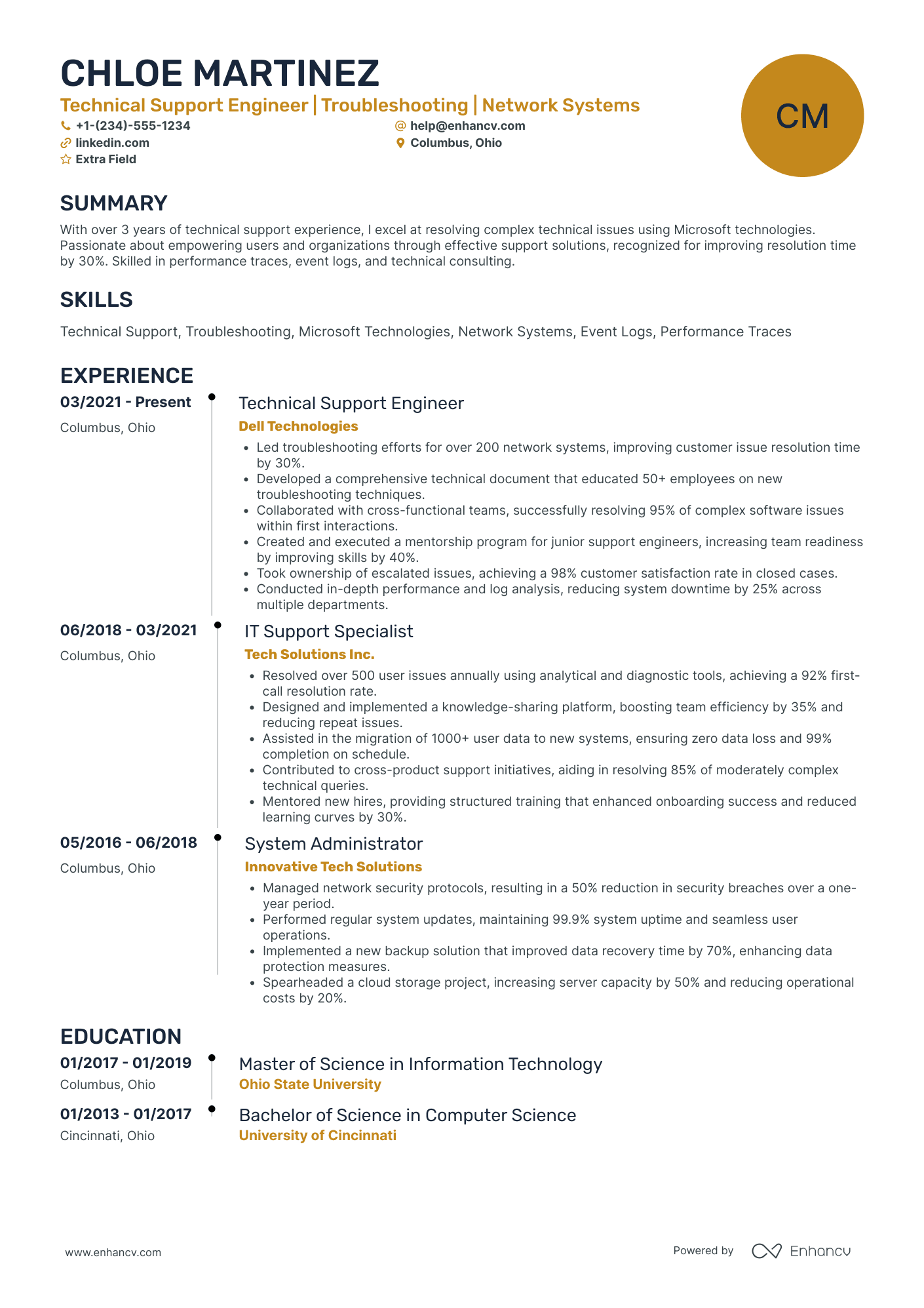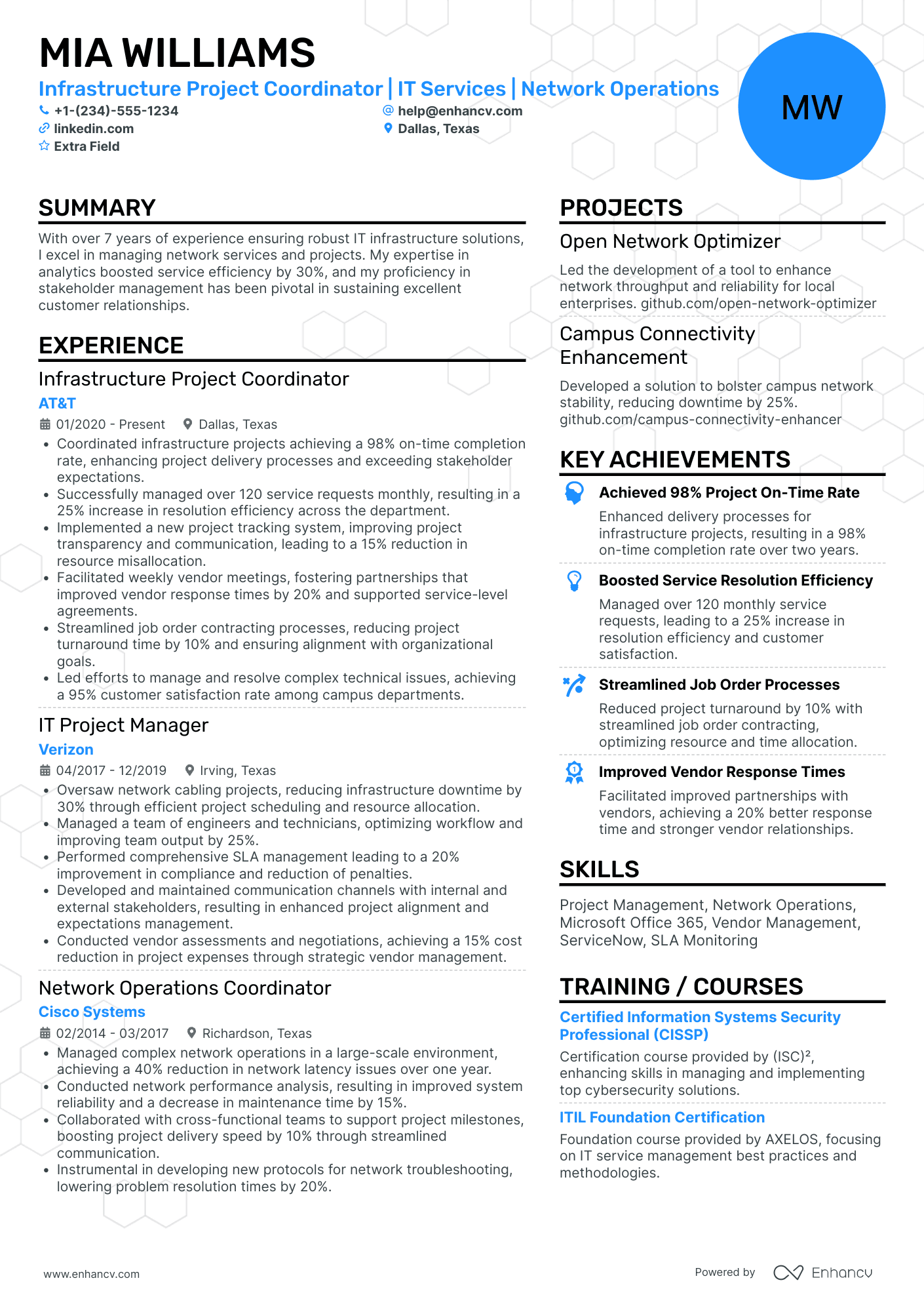Remember the old Microsoft Windows wallpaper? Charles O'Rear’s photo of sunny pastures, aptly named ‘Bliss’? Back then, many of us imagined running through the green grass.
By the time we got to think about our future, the tech giant had already shown us the insides of its campus.
Now the dream was to one day be able to enjoy Seattle’s native greenery at Microsoft’s headquarters.
To stroll around the parks or tinker with a new idea in the Maker Garage.
It would be nice, wouldn’t it?
It’s not impossible, but you’ll have to convince recruiters you mean business. Even if you’re a college grad, you must show you have what it takes to be a Microsoft employee.
How?
It all starts with a stellar resume. Where you display your skills and highlight your strengths.
We guess at this point you may be wondering, how do I create a resume for Microsoft?
Easy!
Keep reading to find out how.
Just a few of the things our guide will help you with
- How to tailor your resume for the position you’re aiming for
- What does the perfect Microsoft job candidate look like
- How to avoid the most common resume traps if you’re a recent grad
- How to properly showcase your accomplishments using the Microsoft method
- How to describe your abilities and balance out the skills section
- What to do after you submit your resume and what to expect next
- What type of questions you may be asked during your job interview
Looking for related resumes?
How to craft a job-winning Microsoft resume and land an interview
It’s always scary when you think about applying for a job with any of the tech giants. After all, they are big, and the competition is strong.
But don’t give up now. You’ve invested so much time and energy to come this far. Don’t let your resume stop you from pursuing your dreams.
Even if you’re a recent graduate.
So, what do you need to know about writing a resume for a Microsoft position?
Above all, do your research. While there are plenty of hybrid and remote roles, each one has its own requirements. Sometimes this depends on where you’re located.
Since Microsoft services many government offices, some roles demand special clearances. For example, check out this excerpt from a job description for a software engineer role:
"The successful candidate must have an active U.S. Government Top Secret Clearance with access to Sensitive Compartmented Information (SCI) based on a Single Scope Background Investigation (SSBI) with Polygraph. Ability to meet Microsoft, customer and/or government security screening requirements are required for this role. Failure to maintain or obtain the appropriate U.S. Government clearance and/or customer screening requirements may result in employment action up to and including termination."
So, before you start applying for each available role, do your research:
- Where is this position available?
- Is it limited in some way by state laws?
- Would you need a visa, and would you expect Microsoft to provide it?
- Does it require you to travel and where to?
The company offers accommodation where necessary. But you need to be sure that you’re capable of fulfilling your part of the deal.
Next, review Microsoft’s core competencies:
- Collaboration
- Drive for results
- Customer focus
- Influencing for impact
- Judgment
- Adaptability
These can give you a good idea of what the tech giant looks for in a perfect candidate.
Review the company’s track record. See how these competencies translate into real life. Then think of examples from your academic or work history.
Is there any way you can align your experiences with Microsoft’s goals and values?
The company is searching for someone who:
- Shows a proactive attitude, combined with a growth mindset
- Displays high intelligence and strong skills
- Can prove they have the passion for technology. And business acumen to be an industry influencer.
- Has the desire to learn and surpass their own expectations
Sounds like you have to be a superhuman to be able to do this. But it’s actually much simpler than this.
Think about how you’ve displayed these characteristics so far. Talk about your biggest achievements and strengths.
Most importantly, reflect on how these shape you into the professional you are. And how these have helped you build your career.
Show a clear career progression. And don’t forget to link how your skills can help the tech giant reach its goals, too.
The company doesn’t want you to just list your duties. Reflect on how your work has affected your past employers and yourself.
With this being said, how can you fit all this in one page?
Microsoft's recruiters say your resume can be longer than a page. But make sure you:
- summarize everything succinctly
- keep it relevant
- Feature your best achievements on the first page
What about the resume format?
You have three options:
Which one to use would depend on your skills and work experience. If you’re a seasoned professional, then stick to the traditional reverse-chronological format.
Start with your latest successes and projects. But don’t go back further than 10 years.
If you’re a recent grad with several internships under their belt, go for the hybrid resume. This one offers the perfect balance between theory and practice.
Begin with your internships and then move onto academic achievements.
What if you don’t have any experience? Use the functional layout. This format allows you to highlight your skills and how you’ve acquired them.
Especially useful if you’re switching careers. And if this is the case, consider giving the hybrid resume another chance. There are many transferable skills you can show.
Microsoft's recruiters don’t care if you haven’t worked an industry-related job. As long as you can prove you can use your talents for the company’s benefit, you have a chance.
Now that we’ve got the layout, what’s the best way to divide it?
Here is what we suggest:
Critical sections to have on your Microsoft resume:
- A header to list your contact details. And feature your portfolio or social media profiles.
- Resume objective or summary to give a highlight reel of your career
- An experience section to showcase how you’ve applied your skills in real life
- A talent segment to display all your technical and social abilities in one place
- An education and certificates part, where you provide evidence of your qualifications
- Other sections you can include to stand out among other applicants
Use this as a guiding framework for your resume. But what about what you list inside each section?
Before we discuss each part individually, review the following questions. Have them in mind when writing about your experiences.
What do hiring managers want to see in your resume?
- What did you do at your last job? Why do you want to switch jobs?
- Why do you want to work at Microsoft? What do you expect from your life at the company?
- What technologies are you familiar with? Which are your favorite ones?
- In which projects have you used your favorite technology? Why did you choose it over another?
- Would you do any of your projects differently if you had the chance to do them over?
- What is your favorite programming language? Why?
- What was the biggest technical challenge you’ve faced so far? How did you overcome it?
- What did you study? What was your senior project?
- Do you prefer object-oriented, procedural, or functional programming? Why?
- What are Microsoft security patches?
To submit your resume, you’ll need to create an account on the Microsoft Careers page. There, you’ll be able to attach your resume and apply for different roles.
You can apply for as many jobs as you want. There is no limit.
And if you haven’t been approved for a particular role, don’t worry. Your resume will be kept in a shared candidate database. So you can be contacted if further opportunities arise.
How to avoid common mistakes when framing your resume header
One tip Microsoft recruiters share for recent grads is to:
- Use a professional email address. Don’t use the one your university created for you.
- Add your LinkedIn or GitHub profile
These are important as hiring managers want to see you in action. They need to know how serious you are and how you present yourself outside work.
In addition to these, you should also include:
- Your first and last name
- Your address
- Your phone number
- Link to a portfolio
Let’s see how this works.
3 Microsoft Resume Header Examples
This is part of Jasmin’s resume. Do you see anything amiss?
The header starts off well, but there is evident lack of details. An email is helpful, yet sometimes recruiters may need your phone.
Even Microsoft stresses the importance of having all your devices charged up. Currently, the company does only online interviews.
So in order to be completely sure they can reach you, add your phone.
Also, Jasmin hasn’t linked any relevant social media profile or portfolio. Microsoft hiring managers always check candidate’s LinkedIn.
They even recommend you create an account before applying for a job.
What would a better resume header look like?
Take a look at the example below:
Good, but it could be better!
How?
See, Jasmin has given herself the title Junior Software Engineer. As such, it would be more appropriate to include her GitHub or portfolio.
Microsoft hiring managers want to know how your mind works. And how you go about solving problems.
So, the following resume header would be better:
If you have the space, add both LinkedIn and GitHub.
How to make yourself stand out with an iron-clad resume summary
Moving on to the star of the resume - the summary. Why is it so important?
On average, recruiters spend only 6 seconds reviewing your resume. First, they check the resume header, which tells them how serious you are about the job.
Next, they check the resume summary to see if you’ve got what it takes.
Instead of skimming through your whole resume, they scan only the top. And here is where you need to make sure you’ve grabbed recruiters’ attention.
Depending on your level of experience in the industry, you have two options:
- Resume summary - used by tenured professionals
- Resume objective - best for recent grads and those switching careers
What does it have to include?
The summary is a short paragraph describing your skills and best achievements. How short? No more than 5-6 sentences.
Take a look at the samples below.
Optimize your resume summary and objective for ATS
Drop your resume here or choose a file.
PDF & DOCX only. Max 2MB file size.
3 Microsoft Resume Summary Examples
Here is a prime example of how not to write a resume summary:
What’s wrong with it?
First things first, who has 3 years of experience and is still a junior? This can mean two things:
- Either the applicant lies about their experience
- Or there is something strange going on with their current employers
Also, there’s no substance to the resume. The candidate seeks to benefit from working at Microsoft, yet she has nothing to offer in return.
Finally, the mere mention of being an MIT graduate sounds insincere.
How can we make the summary better?
Have a look at the example below:
Inspiring, right?
You’ve got:
- An enthusiastic and entrepreneurial college graduate
- Verifiable internships
- Skill specialization
What’s not to love? This applicant is definitely getting a callback.
What about one for the marketing specialists? We’ve got you!
How to properly frame the experience section of your Microsoft resume
Again, this one depends on how long you’ve been in the industry.
For recent grads - include both internships and part-time jobs. Even if these jobs weren’t tech-related. You have many transferable skills.
Worked in retail or in a restaurant? Then you have customer service skills. You know how to assess customers’ needs.
Microsoft's recruiters want to see how you’ll apply these abilities should they hire you.
They also recommend using the STAR® method of describing your experience. What does STAR® stand for?
- Situation
- Task
- Action
- Result
- Reflection
This means you’ll need to be very specific with your examples. Think of situations where your actions made all the difference.
Now reflect on what were the results and how they’ve shaped your career path. Are you proud of the decisions you’ve made?
Don’t forget to lead with numbers. Data speaks louder than words.
Let’s see this in action.
3 Microsoft Resume Experience Examples
Does this experience entry look convincing to you?
- •Designed and launched over 50 marketing campaigns.
- •Helped 3 start-ups establish themselves.
- •Built and mentored 6 digital marketing teams.
No, it shouldn’t.
Where are the mistakes?
It’s always a good idea to include a description of the company and its website. Especially for tech companies.
Most of their work is shared online. If you want to reference extra projects you’ve worked on, this is a great way to do it.
Also, the formatting here is off. If any of the added entries is your current place of employment, mark it with ‘Ongoing’.
Finally, don’t just list your responsibilities. Take the last bullet point for example. Jasmin states she’s built and mentored 6 marketing teams.
Why did she build them? Were 6 teams absolutely necessary? Were the teams built directly because of her actions?
That’s why providing context is important.
Check out a revised version of this entry:
- •Designed, launched and completed over 50 marketing campaigns, while coordinating several cross-functional teams, raking in $750 million in earned revenue across all projects.
- •Helped 3 start-ups establish themselves as industry and market leaders within their verticals in the span of 2 years.
- •Built and mentored 6 digital marketing teams by fostering a learning environment within the agency and creating the 'Pay-It-Forward' learning scheme.
Wow, right?
Here is another example for the technical specialists among you:
- •Increased developer velocity by 79% by improving internal feedback processes and working closely with the department Product Owner.
- •Worked closely with clients and developed 6 patches for the company's key security product, thus preventing over $1.2 billion in revenue losses.
- •Initiated and led a course in cloud security management for admins, which resulted in 95% increase in repeat subscriptions.
How to balance out your talents on your Microsoft resume
Why is this important?
You need to tell a well-rounded story. You have to be well-versed in both tech and people.
That’s why Microsoft emphasizes that the perfect candidates are tech-savvy entrepreneurs.
As such, you’ll have to make room for both hard and soft skills. If the bulk of your resume is filled with techie jargon, talk about your social talents.
Don’t know how?
Let’s start with your hard skills.
How to Describe Your Core Skills and Get Noticed by Recruiters
These are notoriously easy to describe. You have your core talents and tools, and you know how to use them. And you can easily prove it.
Managed a database? You possibly know SQL and/or Python.
Wrote a website? Then you know HTML and JavaScript at the very least.
But how do you know which of your abilities are relevant? Examine the job description. Are there any real life examples you can think of? Add them.
Need more suggestions? Have a look at the table below:
Essential core talents for Microsoft software engineers:
- C#
- C++
- C
- Java
- Industry programming
- Software development
- Software engineering
- Experience with codebases
- Implementation of code level patterns
- Experience with frontend applications
- Experience with server and/or service applications
- Troubleshooting
- Debugging skills
- Experience with reliable distributed solutions (building, shipping and operating)
- Golang
- Linux
- Kubernetes
- Networking and telephony protocols (HTTPS, TCP/IP, SIP, ICE, RTP, RTCP)
- Azure
- AWS
- React
- Angular
- JavaScript
- TypeScript
- GraphQL
- Apollo
- Python
- REST API's
- Experience with cloud-scale services
- Server/service management
- ASP.NET
Key technical abilities for a Microsoft technical program manager:
- Experience with security products
- Threat modeling
- Security design
- Infrastructure security
- Security architecture
- Cryptography
- Program management
- Border security technologies
- Agile principles and frameworks
- Experience with Azure DevOps
- Microsoft Power Apps
- Microsoft Power BI
- Jira
- Tableau
- Experience running security breach response drills
- Security monitoring
- IAM
- Data protection and encryption
- Security response
- Ability to maintain a high-tech supply chain capability roadmap
- Supply chain planning and execution
- Ability to manage and develop business processes and metrics
- Security advocate and evangelist
What about those in the Sales and Marketing Department? Here you go:
Vital hard skills list for a Microsoft marketing specialist:
- People management experience
- Experience with security solutions and security operational practices
- Product marketing
- Leadership skills
- Communication skills
- Ability to work together with stakeholders
- Ability to build and lead teams
- The ability to be a brand ambassador
- Digital marketing
- Relationship marketing
- SMM
- Event management
- Business planning
- Marketing operations
- Product strategy
- Understanding of customers' needs
- Ability to prioritize
- Economics
- Creativity
- Resourcefulness
- Digital event production
- Integrated marketing planning
- Customer journey design
- Building highly collaborative relationships with partners
- Microsoft Azure
- Dynamics 365
- Power Platform
- Microsoft Security
- Microsoft 365
How to measure your social talents and impress hiring managers
All you need to do is measure your soft skills.
Yes, it’s difficult to put a price on social talents. But you can measure how they impact your work. And your team.
What were the results? Link your talents to a specific situation and use the STAR(R) method.
Here is how to do it:
Consider the last entry. Even trying to upskill is worth mentioning sometimes. Especially if it’s relevant to the job role you’re aiming for.
And if you need some inspiration on which social abilities to add, we recommend:
Core soft skills to have on your Microsoft resume:
- Collaboration
- Customer focused
- Communication skills
- Results-oriented
- Ability to influence and empower
- Decision-maker
- Adaptability
- Flexibility
- Growth mindset
- Open-minded
- Critical thinking
- Analytical skills
- Curiosity
- Willingness to learn
- Inquisitiveness
- Responsibility
- Accountability
- Passionate about the industry
- Teamwork
- Management skills
- People management skills
- Leadership skills
- Time management skills
- Organizational skills
- Research skills
- Mentoring skills
- Ability to work in a cross-functional team
- Self-motivated can-do attitude
- Problem-solving skills
- Proactive
- Business-savvy mindset
- Attention to detail
- Ability to assess risks
How important is the education section of your resume?
Very!
Granted, having a formal education from a famous university is always a bonus. And if you were top of your class, even better.
Some of the most popular degrees among Microsoft employees are:
- BA/BS/MS in Computer Science
- BS/MS in a related engineering field
- BS/MS in Marketing
- BS/MS in Business
And if you’re wondering whether to add your GPA, do it only if it’s above 3.5.
Haven’t graduated yet? Don’t worry!
Include the name of your college, your major, and the date you expect to graduate.
But an academic background isn’t absolutely necessary to get hired at Microsoft. As long as you have relevant industry experience, you can still apply.
Are certificates good to have on a Microsoft resume?
Definitely!
Going back to the topic of relevant industry experience. If you haven’t graduated from an elite school, you can prove your work is up to standard with certificates.
Which certificates you’ll list will depend on your background and job role.
Make sure your certificates are up-to-date before you mention them.
What else can give your resume a boost?
Microsoft's recruiters want to get to know you. Not only your professional self, but what you’re interested in, too.
This has much to do with the company's cultural fit. You may not be able to prove some of your soft skills through work projects alone.
But you can do it with additional sections on your resume.
What can you add?
- Extracurricular work
- Volunteer work
- Academic projects
- Club projects
- Research papers and journal articles
- Awards and prizes
- Association memberships
- Languages
- Interests and hobbies
- Leadership opportunities
You have many options to choose from. Just ensure you have all your important information listed first.
If you have some space left, you can append any of the sections above.
Key takeaways: landing your dream job at Microsoft
- Read the job descriptions carefully and consider whether you fit the requirements
- Check for typos and missing information when filling out the header
- Make sure the links to your social media accounts and portfolio work
- List your biggest accomplishments in your resume summary
- Use the STAR® method to describe your professional experience
- Balance out your technical and social talents. Always lead with data.
- Reference peer-reviewed work and relevant certificates to supplement your resume
Microsoft resume examples
By Role

